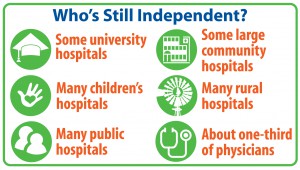Can Your Organization Survive as an Independent Entity?
Hospitals are merging in greater numbers than they have in years. While the number of consolidations is not yet as high as the last merger wave in the late 1990s, further consolidation is expected. The number of deals doubled to 105 in 2012 from 50 in 2009, according to Irving Levin Associates. The industry is expected to eventually be comprised of large systems, niche providers, and a small number of organizations that meet the unique needs of specific local and regional populations.
The stakes appear to be higher with this current round of consolidation as systems get bigger and leaner with regional, state, and national scope, potentially making it harder for independent hospitals to compete. Health care reform has intensified the challenges independent hospitals were already confronting such as low margins, tightening capital markets, increased competition, and physician recruitment and alignment.
The appeal of partnering varies based on market dynamics, state regulatory mandates, and other influences, but there are commonalities on the wish lists of independent hospitals. Economies of scale and scope, expanded geographic reach, access to capital, quality of care improvements, and a foundation upon which they can assume risk and manage population health are among the top priorities. Despite the appeal and advantages of affiliation, many independent hospitals have not jumped on the partnership bandwagon. Deep historical commitment to their local mission and a desire to maintain local control are among the complex issues that independent hospitals must consider. With so much at stake, a thoughtful and thorough evaluation of independent hospitals’ capacity to stay independent is called for.
Characteristics of Successful Independent Providers
Successful independent providers exhibit the ten characteristics listed below. Leadership of independent hospitals should measure and monitor the organization’s position in these areas on an ongoing basis. If the organization is strong or dominant in these areas, it has the potential to remain viable as an independent organization. If an independent organization is moderate to weak or declining, consideration of a partnership strategy may be needed.
- Leading market position– both overall and in major clinical service lines (e.g., market share of 50% or higher in the service area)
- High-quality, aligned physicians– active medical staff with high-quality physicians who are aligned with organizational goals and objectives, in sufficient supply to meet the needs of residents served, and with the proportion of primary care physicians increasing to meet rising demand under health care reform
- Market equilibrium for supply/demand of hospital services– relative equilibrium of hospital services is in place in the market with neither a significant oversupply or undersupply relative to population-based demand
- Low cost structure– cost indicators are below local/regional medians and the organization is considering innovative approaches to cost management/reduction
- Significant, increasing net asset position– net assets or total equity is proportionally more than 75% of total assets
- Strong liquidity position– for example, days cash on hand in excess of 175 days and ratio of current assets to current liabilities in excess of 3.25
- Less debt on hand– proportion of total debt to total assets is less than 25%
- Lower age of plant– average age of plant is less than 12 years
- Favorable payor mix– payor characteristics and what designates a favorable payor mix vary from market to market; nonetheless, a favorable payor mix may entail 50% or more non-government payor mix, with commercial reimbursement rates averaging in excess of 125% of Medicare rates
- Leadership breadth and depth– attributes of a strong organization include engaged, progressive board members, bold and opportunistic executive leadership, and diverse, well-trained, and capable staff throughout the organization
Increasing financial pressures necessitate a proactive approach by leadership when considering whether their organization can remain independent. By evaluating and monitoring the characteristics noted above, an organization can act in the best interest of its stakeholders, sustain value, and ensure continued provision of health care services to the communities they serve. Waiting too long to begin the process of considering a partnership may substantially weaken negotiating positions and ultimately diminish the value and results of a partnership.
